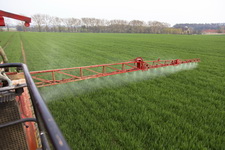
Report: Weed Control Changes and Herbicide Tolerant Crops in the USA 1996-2012
January 7, 2015| |
 Graham Brookes of PG Economics documented and analyzed the trends of weed control changes and herbicide tolerant (HT) crops in the USA from 1996 to 2012. The findings are published in GM Crops and Food journal.
Graham Brookes of PG Economics documented and analyzed the trends of weed control changes and herbicide tolerant (HT) crops in the USA from 1996 to 2012. The findings are published in GM Crops and Food journal.
According to the report, the use of HT technology resulted to net reduction in both the amount of herbicide used and associated environmental impact when compared to the use of conventional production methods. HT technology facilitated many farmers to switch from plough-based to no-tillage or conservation tillage production system and reap economic and environmental advantages. A broad range of, mostly selective herbicides has been replaced by one or 2 broad-spectrum herbicides (mostly glyphosate) used in conjunction with one or 2 other (complementary) herbicides. By mid-2000, herbicide application and the associated environmental load have increased on both HT and conventional crops. The main reason for such is the increasing incidence of weed species developing populations resistant to herbicides and increased awareness of the growers on the consequences of using limited number of herbicides for weed control. Thus, growers use other herbicides in combination with glyphosate even if weed resistance to glyphosate have not been found. This strategy is influenced by their desire to continue using no-tillage or conservation tillage production system.
Read more at http://www.tandfonline.com/doi/full/10.4161/21645698.2014.958930#.VKyI1yuUfE0.
| |
Biotech Updates is a weekly newsletter of ISAAA, a not-for-profit organization. It is distributed for free to over 22,000 subscribers worldwide to inform them about the key developments in biosciences, especially in biotechnology. Your support will help us in our mission to feed the world with knowledge. You can help by donating as little as $10.
-
See more articles:
-
News from Around the World
- FAO: Global Efforts Needed to Stop Deadly Banana Disease
- Biotech and Traditional Farming are Compatible Approaches to Sustainable Agri, Study
- Kenya Bets on High Value Sorghum to Boost Yields
- Training for Faculty of Agriculture With Nanotech Company in Egypt
- New Study Provides Better Understanding of the Genetic Basis for Drought Tolerant Soybeans
- Wheat Gene Increases Blight Resistance of American Chestnut Trees
- USDA Clears GM Tall Fescue
- Report: Weed Control Changes and Herbicide Tolerant Crops in the USA 1996-2012
- Book on GM Crops' Myths and Facts Released in India
- China Approves Imports of Biotech Crops
- Study Shows European Consumers' Attitudes towards Cisgenic Rice
-
Research Highlights
- Effect of the ahas Transgene on Biological Nitrogen Fixation and Yield of Soybean
-
Beyond Crop Biotech
- Scientists Map Loops in Human Genome
-
From the BICs
- IndoBIC Concludes Seminar on Stewardship of Late Blight Resistant Potato in Bogor
- IndoBIC Holds Media Visit to Seed Industries in East Java
-
Read the latest: - Biotech Updates (December 3, 2025)
- Gene Editing Supplement (November 26, 2025)
- Gene Drive Supplement (February 22, 2023)
-
Subscribe to BU: - Share
- Tweet
